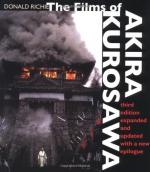|
This section contains 1,722 words (approx. 6 pages at 300 words per page) |

|
SOURCE: "The Spirit of Compassion: Kurosawa's Rhapsody in August," in Cineaste, Vol. XIX, No. 1, 1992, pp. 48-49.
[Tadao Sato is one of the most noted film critics in Japan. In the following essay, he provides a plot summary of the film Dreams, and responds to the charges of some other critics that the film is anti-American.]
All of Akira Kurosawa's recent films are deeply tinged by motifs of death and destruction. Both Kagemusha and Ran are tales of the destruction of the shogun's clan during the Sengoku period, but in their repeated images of warriors endlessly facing death in meaningless battles, there is a deep-rooted despair which transcends the special nature of that age. The very darkness of these films forces us to wonder whether these dreams are not foretelling the destruction of humanity itself. As expected, in Dreams, images of the end of the world and of the...
|
This section contains 1,722 words (approx. 6 pages at 300 words per page) |

|


